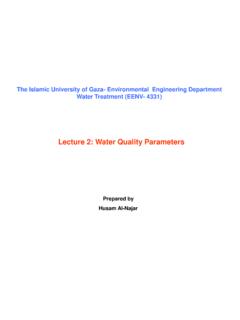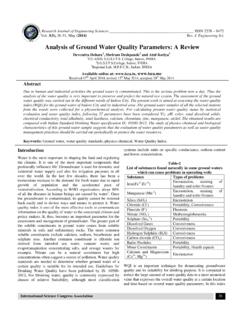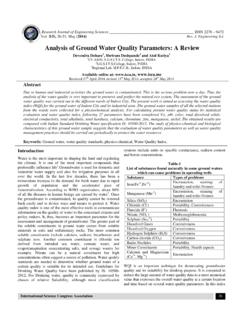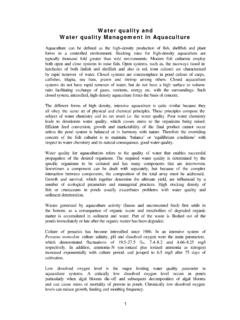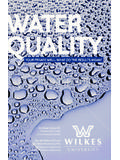Transcription of INTRODUCING PARAMETERS FOR THE ASSESSMENT OF …
1 47 Chapter 2 INTRODUCING PARAMETERS FOR THE ASSESSMENT OFDRINKING water QUALITYP. Payment, M. Waite and A. DufourNote: Inspiration and some text from World Health Organization (WHO) Guidelines(WHO, 1996; 1997) have been used for the preparation of this 1 introduced the index and indicator concept and outlined anumber of microorganisms (and groups of microorganisms) that have beenadopted in the quest to determine whether or not drinking water ismicrobiologically safe to drink. This chapter examines the range of bothmicrobial and non-microbial PARAMETERS and briefly outlines their uses andapplications. It is intended to act as an introduction to the PARAMETERS that can beused to assess drinking water quality and further details on their use in specificareas can be found in subsequent early impetus behind the bacteriological examination of drinkingwater was to determine whether water as consumed was contaminated.
2 Muchwater consumed received no treatment and such treatment as was applied wasmainly intended to improve aesthetic quality . At that time what was requiredwas what is now referred to as an Index organism, although the term Indicatorwas generally applied. It has since been recognised that microbial parameterscan provide useful information throughout the drinking water productionprocess, including catchment survey, source water characterisation, treatmentefficiency and examination of the distribution system. Adopting the index andindicator terminology as advocated by Waite (1991) and briefly outlined inChapter 1, index organisms can give a measure of the amount of faecalpollution in a water source, whereas indicator PARAMETERS may be used to give48information on the effectiveness with which specific groups of microorganismshave been removed or inactivated by treatment processes, with their presenceafter treatment indicating that pathogens may still be present.
3 For example, thepresence of spores of sulphite-reducing clostridia or bacteriophages in treateddrinking water suggests that highly persistent microorganisms may havesurvived, while colony counts of aerobic heterotrophic bacteria or directmicroscopic counts can provide information on the availability of nutrients inthe water , which may result in aesthetic problems or in the presence ofopportunistic many waterborne pathogens can now be detected (and, indeed, anumber are outlined in this chapter) the methods for their detection are oftendifficult to implement, relatively expensive, and time-consuming. Furthermore,the original logic behind the indicator (now index) concept still holds true, inthat a range of pathogens may be shed into water from the faecal matter ofinfected people and animals, and there are enteric pathogens as yetunrecognised.
4 As such, it is neither practicable nor recommended to examinewater for every known pathogen that might be present. Examination of finishedwaters for pathogens will only permit confirmation that consumers have beenexposed to the pathogens whereas examination for non-pathogenic organisms asan index of faecal pollution or an indicator of adequacy of treatment permitsrecognition of the potential for pathogens to be present without the need fortheir actual presence. This chapter describes the index/indicator PARAMETERS andhighlights those that are best suited to a range of purposes (which are exploredfurther in subsequent chapters), with the main thrust being towards minimisingfaecal-oral disease parametersThis section outlines microbial PARAMETERS used to assess drinking waterquality, examining the most appropriate uses, ease of analysis and some of theimplications and responses relating to finding a positive sample.
5 Characteristicssuch as speed of measurement, technical difficulty of the assay, microbialenvironmental survival and resistance to treatment are summarised at the end ofthe Section in Table , while Table summarises the applicability andsuitability of each parameter for assessing source water , treatment efficiencyand so number of documents contain detailed information on taking samples foranalysis of microbial PARAMETERS and their storage and transportation (WHO,1997; Anon, 1994; APHA, AWWA, WEF, 1998), however, there are severalkey points that are summarised below:49 Care should be taken that the samples are representative of the waterexamined. This has implications in terms of the location and constructionof the sampling points, the frequency of sampling and also the aseptictechnique employed by the sampler.
6 If the sample contains disinfectant (such as chlorine, chloramine, chlorinedioxide or ozone) sterile sodium thiosulphate should be included in thesample container in order to neutralise any residual. The concentration ofthe residual disinfectant and the pH at the sampling point should bedetermined at the time of collection. In order to minimise changes in the microbial content, samples should notbe exposed to light and should be rapidly cooled to between 4-10 and UNEP recommend that if samples can not be cooled theyshould be examined within two hours of sampling (Bartram and Ballance,1996). Examination of cooled samples should begin as soon as possibleafter collection, ideally within six hours, with 24 hours being consideredthe absolute maximum (WHO, 1997; Bartram and Ballance, 1996).
7 Further details on sampling can be found in Chapter accepted methods of analysis for the microbial parametersdiscussed in this chapter can be found in a number of sources, including Anon(1994) and APHA, AWWA, WEF (1998). The International Organization forStandardization (ISO) also prepares and publishes methods (see Chapter 8).Most of the microbial PARAMETERS discussed below are common in theenvironment and can easily be introduced in the course of sampling or is therefore advisable to be cautious in the response to their detection in asingle sample of treated water in the absence of supporting factors such astreatment problems, risks pointing to recontamination in distribution or lack ofresidual chlorine. Their detection in the presence of supporting factors, inassociated samples, or on re-sampling, however should be taken as strongevidence that the quality of the water in supply has been coliform groupThe coliform group is made up of bacteria with defined biochemical andgrowth characteristics that are used to identify bacteria that are more or lessrelated to faecal contaminants.
8 The total coliforms represent the whole group,and are bacteria that multiply at 37 C. The thermotolerant coliforms are bacteriathat can grow at a higher temperature ( C) and Escherichia coli is athermotolerant species that is specifically of faecal finding of any coliform bacteria, whether thermotolerant or not, in waterleaving the treatment works requires immediate investigation and correctiveaction. There is no difference in the significance of total coliforms,thermotolerant coliforms and E. coli in water leaving a treatment works, as theyall indicate inadequate treatment, and action should not be delayed pending thedetermination of which type of coliform has been detected. Upon detection in adistribution system, investigations must be initiated immediately to discover thesource of the coliforms: Coliform organisms, better referred to as total coliformsto avoid confusion with others in the group, are not an index of faecal pollutionor of health risk, but can provide basic information on source water coliforms have long been utilised as a microbial measure of drinkingwater quality , largely because they are easy to detect and enumerate in have traditionally been defined by reference to the method used forthe group s enumeration and hence there have been many variations dependenton the method of culture.
9 In general, definitions have been based around thefollowing characteristics: Gram-negative, non-spore-forming rod-shapedbacteria capable of growth in the presence of bile salts or other surface-activeagents with similar growth-inhibiting properties, oxidase-negative, fermentinglactose at 35-37 C with the production of acid, gas, and aldehyde within 24-48hours. These definitions presume the use of cultural methods for identificationand enumeration. There has recently been a move towards a genotypicdefinition based on the recognition that in order to ferment lactose, organismsmust possess -galactosidase activity. Using this approach total coliforms aredefined as members of a genus or species within the family Enterobacteriaceaecapable of growth at 37 C and possessing , total coliforms were regarded as belonging to the generaEscherichia, Citrobacter, Enterobacter, and Klebsiella.
10 However, regardless ofthe definition adopted, the group is heterogeneous. It includes many lactose-fermenting bacteria, such as Enterobacter cloacae and Citrobacter freundii,which can be found in both faeces and the environment (nutrient-rich waters,soil, decaying plant material) as well as in drinking water containing relativelyhigh concentrations of also includes members of genera such asBudvicia and Rahnella, which are never found in mammalian total coliforms of non-faecal origin can exist in natural waters,their presence can occasionally be tolerated in unpiped or untreated water , in theabsence of more specific index PARAMETERS . Where it can be demonstrated thatcoliforms in water are not faecally derived and are, thus, of no sanitarysignificance, expenditure to achieve their eradication may be considered51unnecessary and many standards require only absence of total coliforms from95% of samples from within distribution systems.










